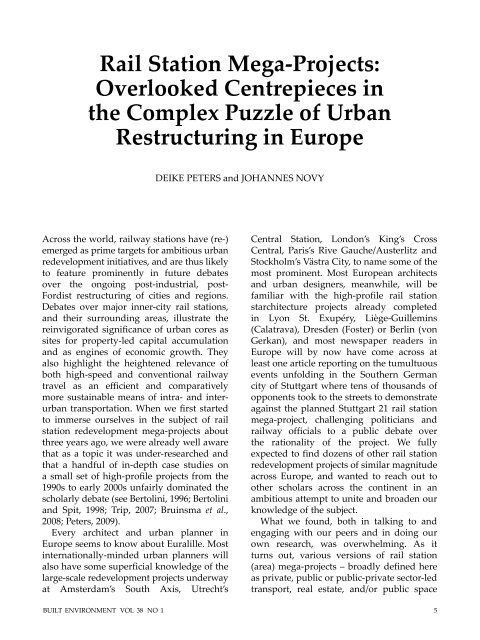Rail Station Mega-Projects - TU Berlin
Rail Station Mega-Projects - TU Berlin
Rail Station Mega-Projects - TU Berlin
You also want an ePaper? Increase the reach of your titles
YUMPU automatically turns print PDFs into web optimized ePapers that Google loves.
RAIL STATION MEGA-PROJECTS<br />
<strong>Rail</strong> <strong>Station</strong> <strong>Mega</strong>-<strong>Projects</strong>:<br />
Overlooked Centrepieces in<br />
the Complex Puzzle of Urban<br />
Restructuring in Europe<br />
Across the world, railway stations have (re-)<br />
emerged as prime targets for ambitious urban<br />
redevelopment initiatives, and are thus likely<br />
to feature prominently in future debates<br />
over the ongoing post-industrial, post-<br />
Fordist restructuring of cities and regions.<br />
Debates over major inner-city rail stations,<br />
and their surrounding areas, illustrate the<br />
reinvigorated signifi cance of urban cores as<br />
sites for property-led capital accumulation<br />
and as engines of economic growth. They<br />
also highlight the heightened relevance of<br />
both high-speed and conventional railway<br />
travel as an effi cient and comparatively<br />
more sustainable means of intra- and interurban<br />
transportation. When we fi rst started<br />
to immerse ourselves in the subject of rail<br />
station redevelopment mega-projects about<br />
three years ago, we were already well aware<br />
that as a topic it was under-researched and<br />
that a handful of in-depth case studies on<br />
a small set of high-profi le projects from the<br />
1990s to early 2000s unfairly dominated the<br />
scholarly debate (see Bertolini, 1996; Bertolini<br />
and Spit, 1998; Trip, 2007; Bruinsma et al.,<br />
2008; Peters, 2009).<br />
Every architect and urban planner in<br />
Europe seems to know about Euralille. Most<br />
internationally-minded urban planners will<br />
also have some superficial knowledge of the<br />
large-scale redevelopment projects underway<br />
at Amsterdam’s South Axis, Utrecht’s<br />
BUILT ENVIRONMENT VOL 38 NO 1<br />
DEIKE PETERS and JOHANNES NOVY<br />
Central <strong>Station</strong>, London’s King’s Cross<br />
Central, Paris’s Rive Gauche/Austerlitz and<br />
Stockholm’s Västra City, to name some of the<br />
most prominent. Most European architects<br />
and urban designers, meanwhile, will be<br />
familiar with the high-profile rail station<br />
starchitecture projects already completed<br />
in Lyon St. Exupéry, Liège-Guillemins<br />
(Calatrava), Dresden (Foster) or <strong>Berlin</strong> (von<br />
Gerkan), and most newspaper readers in<br />
Europe will by now have come across at<br />
least one article reporting on the tumultuous<br />
events unfolding in the Southern German<br />
city of Stuttgart where tens of thousands of<br />
opponents took to the streets to demonstrate<br />
against the planned Stuttgart 21 rail station<br />
mega-project, challenging politicians and<br />
railway officials to a public debate over<br />
the rationality of the project. We fully<br />
expected to find dozens of other rail station<br />
redevelopment projects of similar magnitude<br />
across Europe, and wanted to reach out to<br />
other scholars across the continent in an<br />
ambitious attempt to unite and broaden our<br />
knowledge of the subject.<br />
What we found, both in talking to and<br />
engaging with our peers and in doing our<br />
own research, was overwhelming. As it<br />
turns out, various versions of rail station<br />
(area) mega-projects – broadly defined here<br />
as private, public or public-private sector-led<br />
transport, real estate, and/or public space<br />
5

















